ESP Alfa Romeo 4C 2015 Owner handbook (in English)
[x] Cancel search | Manufacturer: ALFA ROMEO, Model Year: 2015, Model line: 4C, Model: Alfa Romeo 4C 2015Pages: 199, PDF Size: 7.67 MB
Page 115 of 199
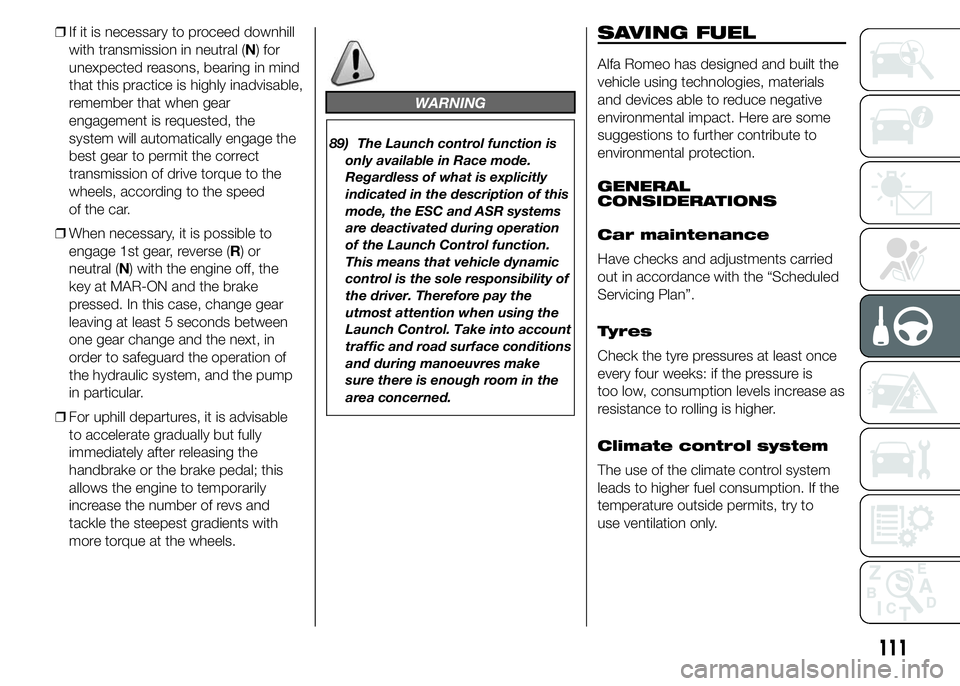
❒If it is necessary to proceed downhill
with transmission in neutral (N) for
unexpected reasons, bearing in mind
that this practice is highly inadvisable,
remember that when gear
engagement is requested, the
system will automatically engage the
best gear to permit the correct
transmission of drive torque to the
wheels, according to the speed
of the car.
❒When necessary, it is possible to
engage 1st gear, reverse (R)or
neutral (N) with the engine off, the
key at MAR-ON and the brake
pressed. In this case, change gear
leaving at least 5 seconds between
one gear change and the next, in
order to safeguard the operation of
the hydraulic system, and the pump
in particular.
❒For uphill departures, it is advisable
to accelerate gradually but fully
immediately after releasing the
handbrake or the brake pedal; this
allows the engine to temporarily
increase the number of revs and
tackle the steepest gradients with
more torque at the wheels.
WARNING
89) The Launch control function is
only available in Race mode.
Regardless of what is explicitly
indicated in the description of this
mode, the ESC and ASR systems
are deactivated during operation
of the Launch Control function.
This means that vehicle dynamic
control is the sole responsibility of
the driver. Therefore pay the
utmost attention when using the
Launch Control. Take into account
traffic and road surface conditions
and during manoeuvres make
sure there is enough room in the
area concerned.
SAVING FUEL
Alfa Romeo has designed and built the
vehicle using technologies, materials
and devices able to reduce negative
environmental impact. Here are some
suggestions to further contribute to
environmental protection.
GENERAL
CONSIDERATIONS
Car maintenance
Have checks and adjustments carried
out in accordance with the “Scheduled
Servicing Plan”.
Tyres
Check the tyre pressures at least once
every four weeks: if the pressure is
too low, consumption levels increase as
resistance to rolling is higher.
Climate control system
The use of the climate control system
leads to higher fuel consumption. If the
temperature outside permits, try to
use ventilation only.
111
Page 117 of 199

SNOW TYRES
Use snow tyres of the same size as the
normal tyres provided with the car:
the dedicated Alfa Romeo Dealership
will be able to advise you on the most
appropriate tyre to use.
Only use these tyres in the event of ice
or snow on the roads. In these
conditions it is recommended to select
the "All Weather" mode of the Alfa
DNA system.
For the type of tyre to be used, inflation
pressures and the specifications of
snow tyres, follow the instructions given
in the "Wheels" paragraph in the
"Technical specifications" chapter.
90)
The performance of these tyres on
low-grip surfaces are reduced
considerably when the tread depth is
below 4 mm. They should be replaced
in this case.
Due to the specific characteristics of
snow tyres, in normal weather
conditions and dry asphalt or on long
motorway journeys, the performance of
these tyres is lower than that of
standard tyres. Their usage should
therefore be restricted in accordance
with their type approval.IMPORTANT When using snow tyres
with a maximum speed index below the
one that can be reached by the car
(increased by 5%), place a notice in the
passenger compartment, plainly in
view, which states the maximum speed
allowed by the snow tyres (as per EC
Directive).
All four tyres should be the same brand
to ensure greater safety when driving
and braking as well as making the
car more responsive. It is inadvisable to
change the rotation direction of tyres.
Refer to the "Raising the car" section in
the "In an emergency" chapter for
further details on how to raise the car
correctly.
WARNING
90) The maximum speed for snow
tyres marked “Q” is 160 km/h,
while it is 190 km/h for “T” tyres
and 210 km/h for "H" tyres. The
highway code speed limits must
however always be complied with.
SNOW CHAINS
Reduced size snow chains with a
maximum projection of 7 mm beyond
the tyre profile can be fitted only on
235/40 R18 rear tyres.
The use of snow chains should be in
compliance with local regulations.
Snow chains can be fitted on the tyres
of the rear wheels (drive wheels) only.
19" rear tyres cannot be fitted with
chains.
Check the tension of the snow chains
after the first few metres have been
driven.
11)
IMPORTANT Snow chains cannot be
fitted to the space-saver wheel (for
versions/markets, where provided).
113
Page 125 of 199

WARNING
92) Indicate the presence of the
stationary car in accordance with
current regulations: hazard
warning lights, warning triangle,
etc. Those on board should get
out of the vehicle and wait for the
wheel to be repaired away from
the threat posed by the traffic.
If parked on a slope or rough
surface, chock the wheels with
wedges or other suitable devices
(for the correct procedure for
parking the car safely, refer to the
"Parking" paragraph in the
"Starting and driving" chapter).
93) Give the booklet to the
technicians who will be handling
the tyre that was treated using
the "Fix&Go automatic" kit.
94) A repair is not possible if the
wheel rim is damaged (groove
is deformed, causing air to
escape). Do not remove foreign
bodies (screws or nails) from the
tyre.95) Do not use the compressor for
more than 20 consecutive
minutes. Risk of overheating. The
kit is not suitable for definitive
repairs, so the repaired tyres may
only be used temporarily.
96) The bottle contains ethylene
glycol and latex: it may cause
an allergic reaction. It is harmful if
swallowed. Eye irritant. It may
cause sensitisation if inhaled or
on contact. Avoid contact with
eyes, skin and clothes. In the
event of contact, rinse
immediately with plenty of water.
If ingested, do not induce
vomiting. Rinse out your mouth,
drink large quantities of water and
seek immediate medical attention.
Keep out of the reach of children.
The product must not be used
by asthmatics. Do not inhale the
vapours during insertion and
suction. Call a doctor immediately
if allergic reactions are noted.
Store the bottle in its special
compartment, away from sources
of heat. The sealant has an expiry
date. Replace the bottle if the
sealant has expired.
97) Wear the protective gloves
provided with the kit.98) Apply the adhesive label where it
can be easily seen by the driver as
a reminder that the tyre has been
treated with the quick repair kit.
Drive carefully, especially on
corners. Do not exceed 80 km/h.
Avoid sudden acceleration or
braking.
99) If the pressure has fallen below
1.8 bar, do not drive any further:
the Fix&Go automatic quick tyre
repair kit cannot guarantee proper
hold because the tyre is too
damaged. Contact a dedicated
Alfa Romeo Dealership.
100) Always indicate that the tyre
was repaired using the quick
tyre repair kit. Give the booklet to
the personnel charged with
handling the tyre treated with the
repair kit.
121
Page 127 of 199

❒push the jack under the car using the
rod until the wording "STOP" on the
rod corresponds with the side skirt:
"FRONT" when replacing the front
wheel, "REAR" when replacing the
rear wheel (see fig. 91 - fig. 92);
❒fit the suitable tool E fig. 90 on the
operating rod;
IMPORTANT As shown in fig. 91 - fig.
92, on the operating rod D there is
the indication of max. limit for front and
rear insertion under car that must
coincide with the mark on the side
skirts.
❒operate the device A so as to extend
the jack, until the upper part B fig. 89
rests correctly in one of the lifting
points shown in fig. 93 - fig. 94,
otherwise, reposition the jack;IMPORTANT Make sure that the upper
part B of the jack rests firmly on the
car underbody in the points shown in
fig. 93 - fig. 94 so as to prevent the car
from falling when it is lifted
❒operate the jack and lift the car until
the wheel is several centimetres off
the ground;
88A0L018389A0L0184
90A0L0186
STOP - FRONT
STOP - FRONT
91A0L0189
STOP - REAR
STOP - REAR
92A0L0190
93 - Rear areaA0L0185
123
Page 130 of 199
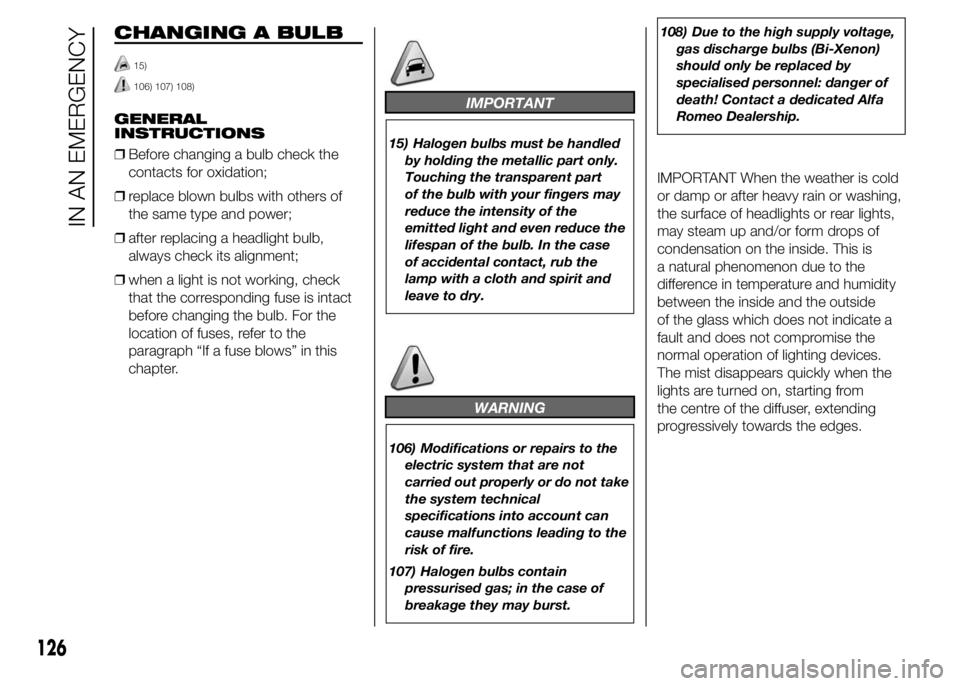
CHANGING A BULB
15)
106) 107) 108)
GENERAL
INSTRUCTIONS
❒Before changing a bulb check the
contacts for oxidation;
❒replace blown bulbs with others of
the same type and power;
❒after replacing a headlight bulb,
always check its alignment;
❒when a light is not working, check
that the corresponding fuse is intact
before changing the bulb. For the
location of fuses, refer to the
paragraph “If a fuse blows” in this
chapter.IMPORTANT
15) Halogen bulbs must be handled
by holding the metallic part only.
Touching the transparent part
of the bulb with your fingers may
reduce the intensity of the
emitted light and even reduce the
lifespan of the bulb. In the case
of accidental contact, rub the
lamp with a cloth and spirit and
leave to dry.
WARNING
106) Modifications or repairs to the
electric system that are not
carried out properly or do not take
the system technical
specifications into account can
cause malfunctions leading to the
risk of fire.
107) Halogen bulbs contain
pressurised gas; in the case of
breakage they may burst.108) Due to the high supply voltage,
gas discharge bulbs (Bi-Xenon)
should only be replaced by
specialised personnel: danger of
death! Contact a dedicated Alfa
Romeo Dealership.
IMPORTANT When the weather is cold
or damp or after heavy rain or washing,
the surface of headlights or rear lights,
may steam up and/or form drops of
condensation on the inside. This is
a natural phenomenon due to the
difference in temperature and humidity
between the inside and the outside
of the glass which does not indicate a
fault and does not compromise the
normal operation of lighting devices.
The mist disappears quickly when the
lights are turned on, starting from
the centre of the diffuser, extending
progressively towards the edges.
126
IN AN EMERGENCY
Page 133 of 199
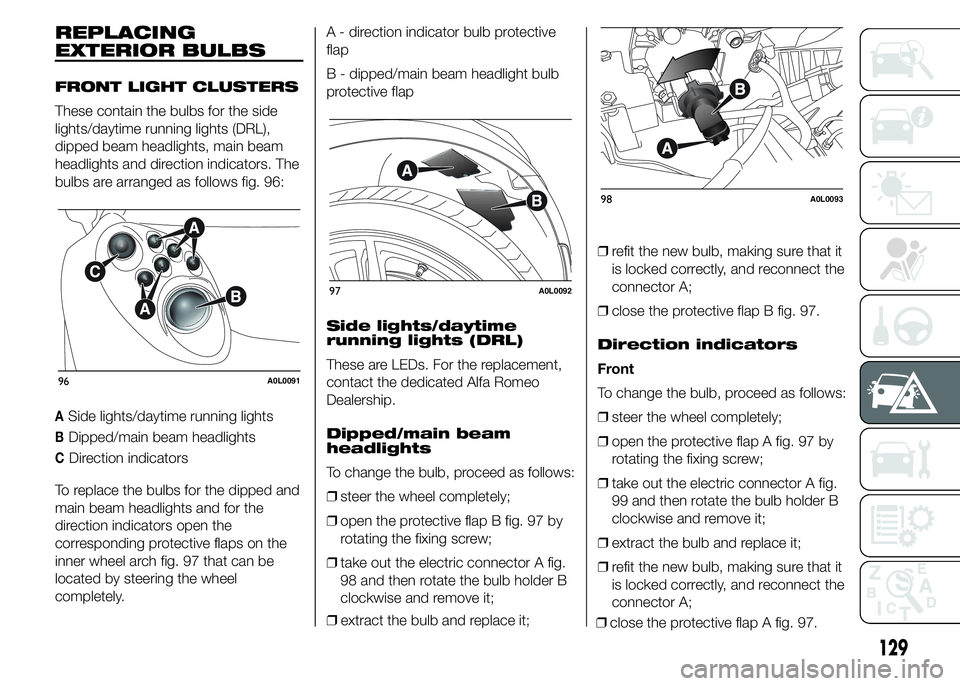
REPLACING
EXTERIOR BULBS
FRONT LIGHT CLUSTERS
These contain the bulbs for the side
lights/daytime running lights (DRL),
dipped beam headlights, main beam
headlights and direction indicators. The
bulbs are arranged as follows fig. 96:
ASide lights/daytime running lights
BDipped/main beam headlights
CDirection indicators
To replace the bulbs for the dipped and
main beam headlights and for the
direction indicators open the
corresponding protective flaps on the
inner wheel arch fig. 97 that can be
located by steering the wheel
completely.A - direction indicator bulb protective
flap
B - dipped/main beam headlight bulb
protective flap
Side lights/daytime
running lights (DRL)
These are LEDs. For the replacement,
contact the dedicated Alfa Romeo
Dealership.
Dipped/main beam
headlights
To change the bulb, proceed as follows:
❒steer the wheel completely;
❒open the protective flap B fig. 97 by
rotating the fixing screw;
❒take out the electric connector A fig.
98 and then rotate the bulb holder B
clockwise and remove it;
❒extract the bulb and replace it;❒refit the new bulb, making sure that it
is locked correctly, and reconnect the
connector A;
❒close the protective flap B fig. 97.
Direction indicators
Front
To change the bulb, proceed as follows:
❒steer the wheel completely;
❒open the protective flap A fig. 97 by
rotating the fixing screw;
❒take out the electric connector A fig.
99 and then rotate the bulb holder B
clockwise and remove it;
❒extract the bulb and replace it;
❒refit the new bulb, making sure that it
is locked correctly, and reconnect the
connector A;
96A0L0091
97A0L0092
98A0L0093
129
❒close the protective flap A fig. 97.
Page 137 of 199
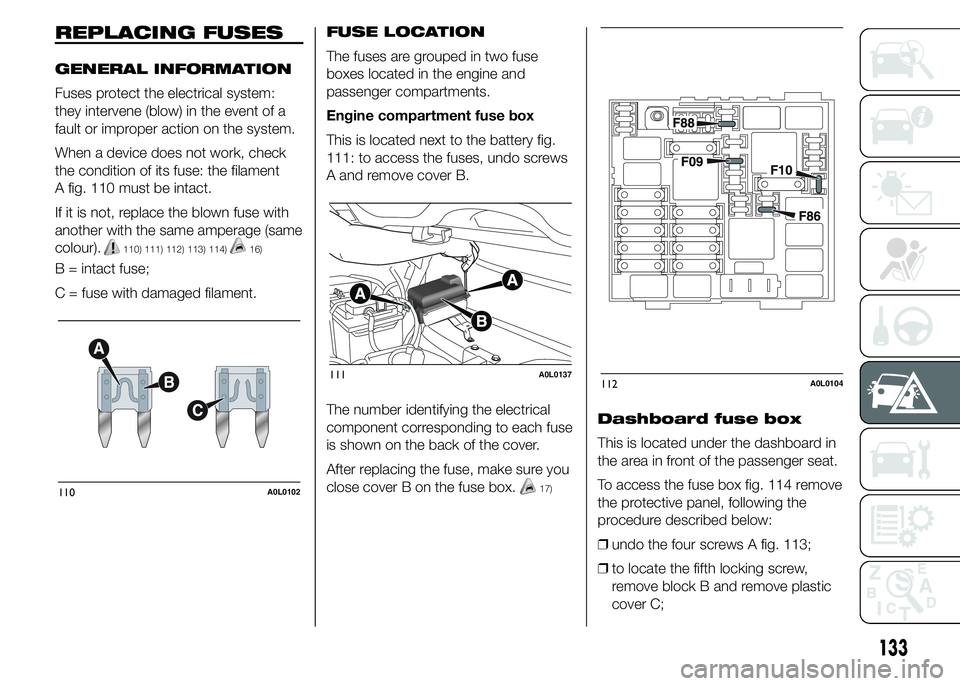
REPLACING FUSES
GENERAL INFORMATION
Fuses protect the electrical system:
they intervene (blow) in the event of a
fault or improper action on the system.
When a device does not work, check
the condition of its fuse: the filament
A fig. 110 must be intact.
If it is not, replace the blown fuse with
another with the same amperage (same
colour).
110) 111) 112) 113) 114)16)
B = intact fuse;
C = fuse with damaged filament.FUSE LOCATION
The fuses are grouped in two fuse
boxes located in the engine and
passenger compartments.
Engine compartment fuse box
This is located next to the battery fig.
111: to access the fuses, undo screws
A and remove cover B.
The number identifying the electrical
component corresponding to each fuse
is shown on the back of the cover.
After replacing the fuse, make sure you
close cover B on the fuse box.
17)
Dashboard fuse box
This is located under the dashboard in
the area in front of the passenger seat.
To access the fuse box fig. 114 remove
the protective panel, following the
procedure described below:
❒undo the four screws A fig. 113;
❒to locate the fifth locking screw,
remove block B and remove plastic
cover C;
110A0L0102
111A0L0137112A0L0104
133
Page 147 of 199
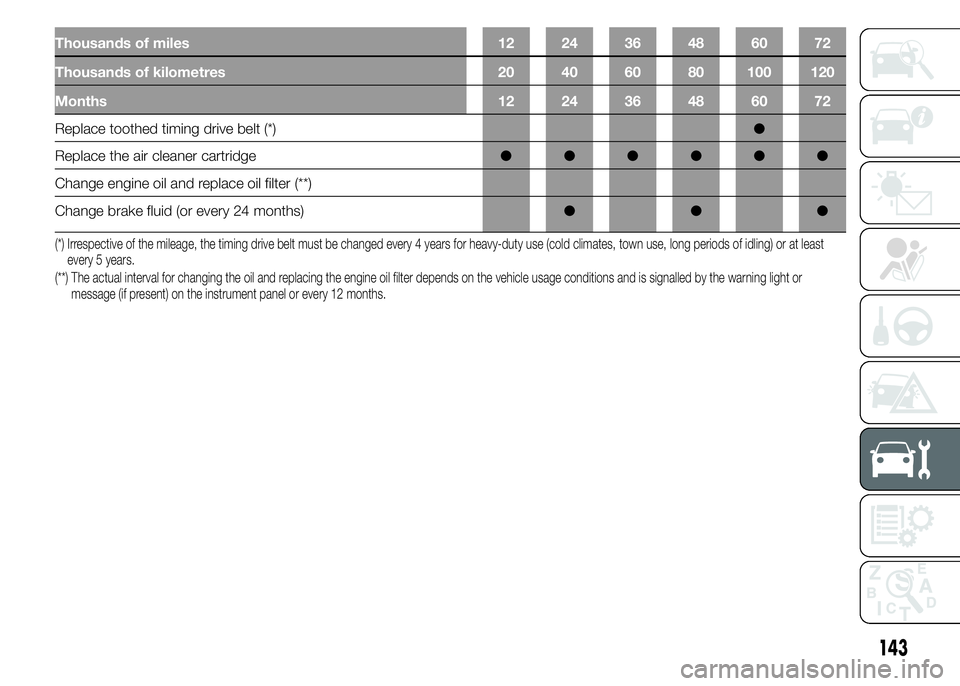
Thousands of miles 12 24 36 48 60 72
Thousands of kilometres 20 40 60 80 100 120
Months 12 24 36 48 60 72
Replace toothed timing drive belt (*)●
Replace the air cleaner cartridge●●●●●●
Change engine oil and replace oil filter (**)
Change brake fluid (or every 24 months)●●●
(*) Irrespective of the mileage, the timing drive belt must be changed every 4 years for heavy-duty use (cold climates, town use, long periods of idling) or at least
every 5 years.
(**) The actual interval for changing the oil and replacing the engine oil filter depends on the vehicle usage conditions and is signalled by the warning light or
message (if present) on the instrument panel or every 12 months.
143
Page 150 of 199
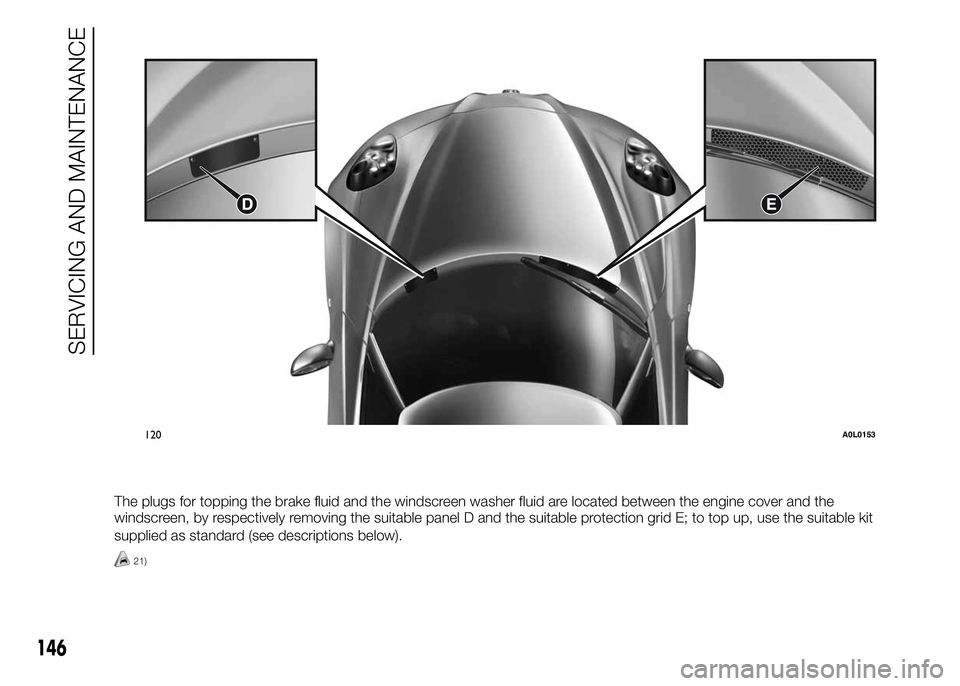
The plugs for topping the brake fluid and the windscreen washer fluid are located between the engine cover and the
windscreen, by respectively removing the suitable panel D and the suitable protection grid E; to top up, use the suitable kit
supplied as standard (see descriptions below).
21)
120A0L0153
146
SERVICING AND MAINTENANCE
Page 151 of 199
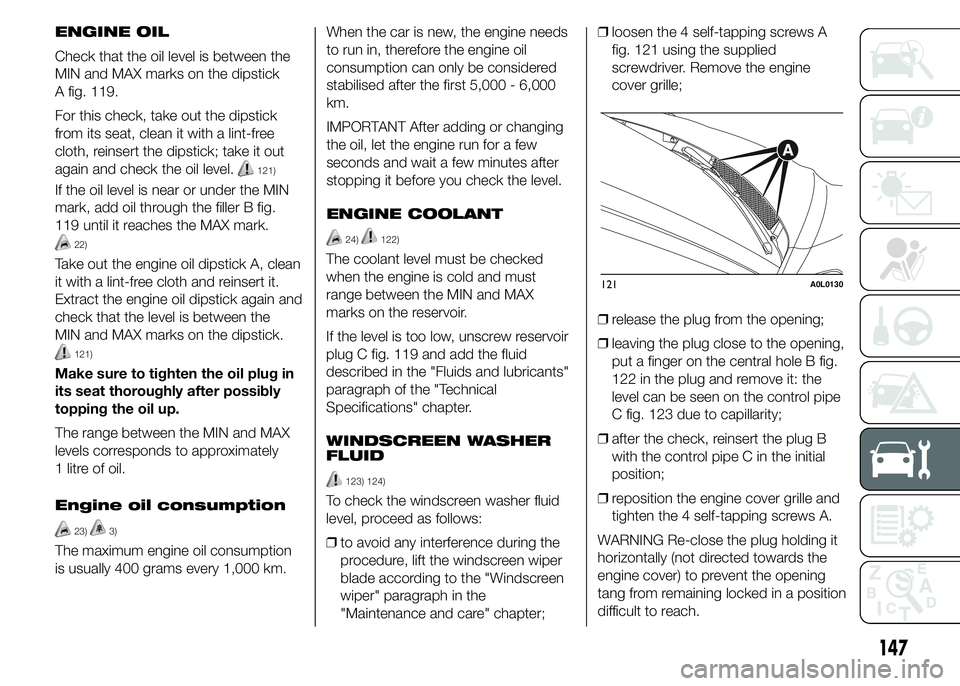
ENGINE OIL
Check that the oil level is between the
MIN and MAX marks on the dipstick
A fig. 119.
For this check, take out the dipstick
from its seat, clean it with a lint-free
cloth, reinsert the dipstick; take it out
again and check the oil level.
121)
If the oil level is near or under the MIN
mark, add oil through the filler B fig.
119 until it reaches the MAX mark.
22)
Take out the engine oil dipstick A, clean
it with a lint-free cloth and reinsert it.
Extract the engine oil dipstick again and
check that the level is between the
MIN and MAX marks on the dipstick.
121)
Make sure to tighten the oil plug in
its seat thoroughly after possibly
topping the oil up.
The range between the MIN and MAX
levels corresponds to approximately
1 litre of oil.
Engine oil consumption
23)3)
The maximum engine oil consumption
is usually 400 grams every 1,000 km.When the car is new, the engine needs
to run in, therefore the engine oil
consumption can only be considered
stabilised after the first 5,000 - 6,000
km.
IMPORTANT After adding or changing
the oil, let the engine run for a few
seconds and wait a few minutes after
stopping it before you check the level.
ENGINE COOLANT
24)122)
The coolant level must be checked
when the engine is cold and must
range between the MIN and MAX
marks on the reservoir.
If the level is too low, unscrew reservoir
plug C fig. 119 and add the fluid
described in the "Fluids and lubricants"
paragraph of the "Technical
Specifications" chapter.
WINDSCREEN WASHER
FLUID
123) 124)
To check the windscreen washer fluid
level, proceed as follows:
❒to avoid any interference during the
procedure, lift the windscreen wiper
blade according to the "Windscreen
wiper" paragraph in the
"Maintenance and care" chapter;❒loosen the 4 self-tapping screws A
fig. 121 using the supplied
screwdriver. Remove the engine
cover grille;
❒release the plug from the opening;
❒leaving the plug close to the opening,
put a finger on the central hole B fig.
122 in the plug and remove it: the
level can be seen on the control pipe
C fig. 123 due to capillarity;
❒after the check, reinsert the plug B
with the control pipe C in the initial
position;
❒reposition the engine cover grille and
tighten the 4 self-tapping screws A.
WARNING Re-close the plug holding it
horizontally (not directed towards the
engine cover) to prevent the opening
tang from remaining locked in a position
difficult to reach.
121A0L0130
147